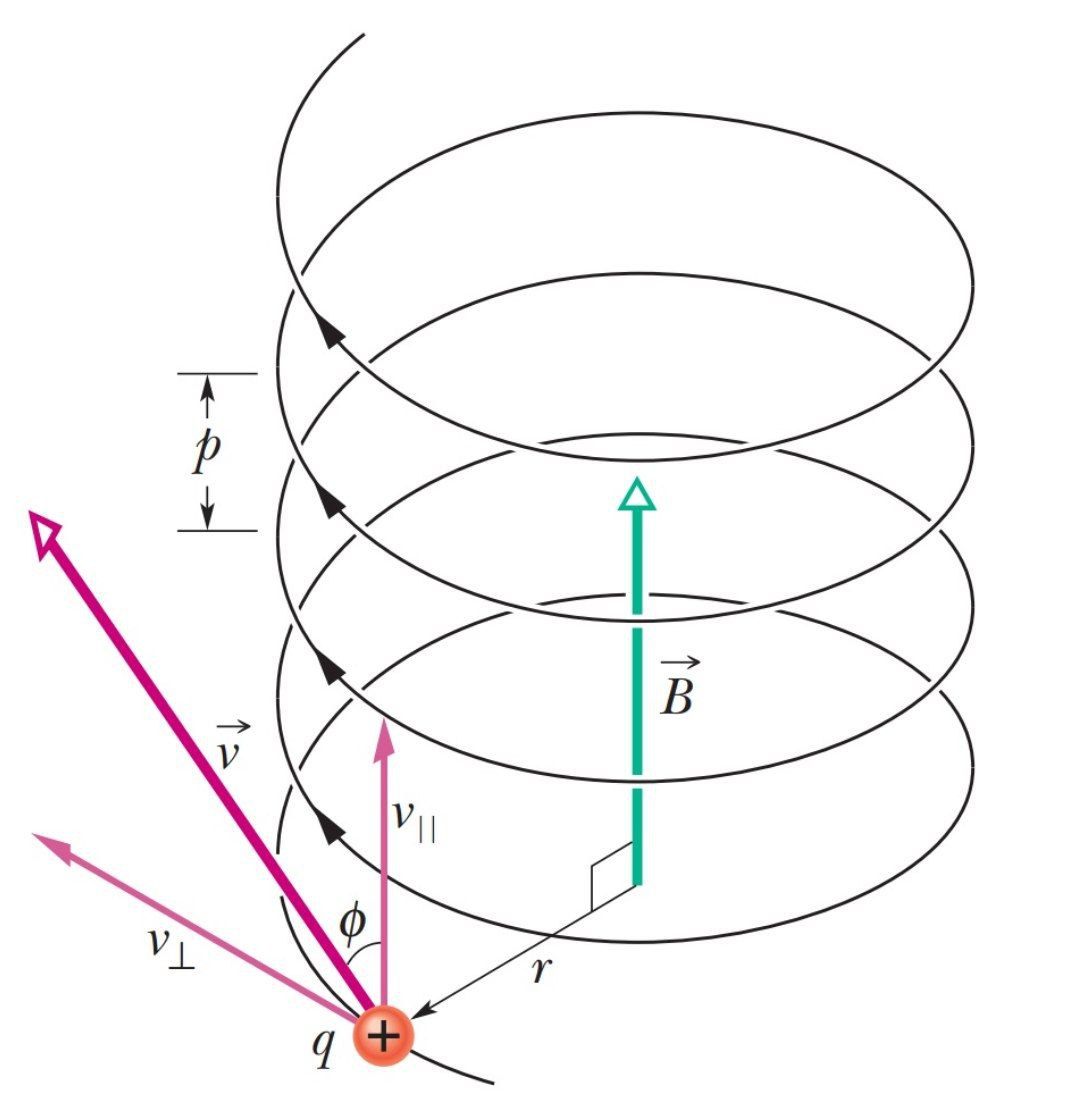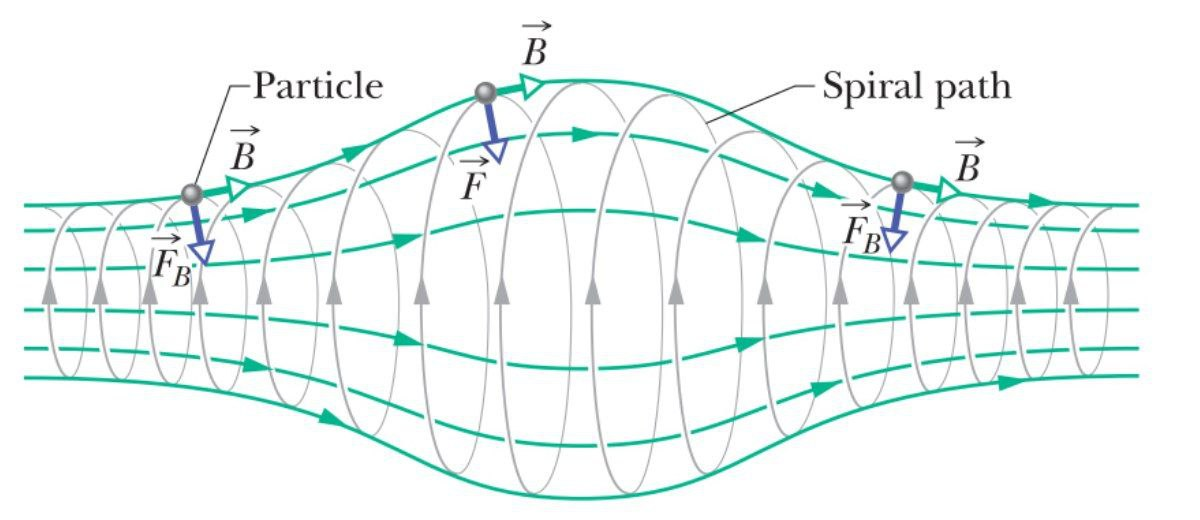
Answer
419.4k+ views
Hint: When a charged particle moves in a magnetic field it experiences a force. The direction of this force is perpendicular to the magnetic field and direction of motion of the charged body. So the charged body will deviate from its original path because of this force.
Formulas used:
When a charged particle having charge $q$ and velocity $\overrightarrow{v}$ enters a magnetic field $\overrightarrow{B}$, it experiences a force given by
$\overrightarrow{F}=q\left( \overrightarrow{v}\times \overrightarrow{B} \right)$ The direction of this force is perpendicular to the magnetic field and direction of motion of the charged body. Its magnitude is given by
$F=qvB\sin \phi $, where
$\phi =\text{ angle between }\overrightarrow{v}\text{ and }\overrightarrow{B}$
Complete answer:
The force on a charged particle moving in magnetic field is given by
$\overrightarrow{F}=q\left( \overrightarrow{v}\times \overrightarrow{B} \right)$ Or $F=qvB\sin \phi $
$\phi =\text{ angle between }\overrightarrow{v}\text{ and }\overrightarrow{B}$
Consider a uniform magnetic field $\overrightarrow{B}$ is acting along the positive x-axis. A particle of charge ‘q’ and mass ‘m’ enters the field $\overrightarrow{B}$with velocity $\overrightarrow{v}$inclined at an angle $\phi $with the direction of field.

The velocity \[\overrightarrow{v}\] can be resolved into two rectangular components
(i) The component along parallel direction of field i.e. along x-axis which is given by
${{v}_{\parallel }}=v\cos \phi $
The parallel component remains unaffected by the magnetic field and so the charge particle continues to move along the field with the speed $v\cos \phi $.
(ii)The component perpendicular to the direction of field i.e. in the YZ-plane. And is given by
${{v}_{\bot }}=v\sin \phi $
Due to this component of velocity, the charged particle experiences a force $F=q{{v}_{\bot }}B$ which acts perpendicular to both ${{v}_{\bot }}$ and $B$. This force makes the particle move along a circular path in the YZ-plane. The radius of this circular path is.
$r=\dfrac{m{{v}_{\bot }}}{qB}=\dfrac{mv\sin \phi }{qB}$
The period of revolution is
$T=\dfrac{2\pi r}{{{v}_{\bot }}}=\dfrac{2\pi }{v\sin \phi }\times \dfrac{mv\sin \phi }{qB}=\dfrac{2\pi m}{qB}$
Thus a charged particle moving in uniform magnetic field has two concurrent motions
(i) A linear motion in the direction of the field
(ii)A circular motion in perpendicular to the field.
Therefore the resultant path of a charged particle will be a helix with its axis along the direction of the field.
So the correct option is C. Helical.
Note:
The linear distance travelled by the charge particle in the direction of magnetic field during its period of revolution is called pitch of the helical path and is given by.
$\text{pitch,p}={{v}_{\parallel }}\times T=v\cos \phi \times \dfrac{2\pi m}{qB}=\dfrac{2\pi mv\cos \phi }{qB}$.
A charged particle moving in a non-uniform field with initial velocity making some angle with the field will be also helical. But the path is not a uniform helix; it will be a non-uniform helix, with more radius in the region of more field.

Formulas used:
When a charged particle having charge $q$ and velocity $\overrightarrow{v}$ enters a magnetic field $\overrightarrow{B}$, it experiences a force given by
$\overrightarrow{F}=q\left( \overrightarrow{v}\times \overrightarrow{B} \right)$ The direction of this force is perpendicular to the magnetic field and direction of motion of the charged body. Its magnitude is given by
$F=qvB\sin \phi $, where
$\phi =\text{ angle between }\overrightarrow{v}\text{ and }\overrightarrow{B}$
Complete answer:
The force on a charged particle moving in magnetic field is given by
$\overrightarrow{F}=q\left( \overrightarrow{v}\times \overrightarrow{B} \right)$ Or $F=qvB\sin \phi $
$\phi =\text{ angle between }\overrightarrow{v}\text{ and }\overrightarrow{B}$
Consider a uniform magnetic field $\overrightarrow{B}$ is acting along the positive x-axis. A particle of charge ‘q’ and mass ‘m’ enters the field $\overrightarrow{B}$with velocity $\overrightarrow{v}$inclined at an angle $\phi $with the direction of field.

The velocity \[\overrightarrow{v}\] can be resolved into two rectangular components
(i) The component along parallel direction of field i.e. along x-axis which is given by
${{v}_{\parallel }}=v\cos \phi $
The parallel component remains unaffected by the magnetic field and so the charge particle continues to move along the field with the speed $v\cos \phi $.
(ii)The component perpendicular to the direction of field i.e. in the YZ-plane. And is given by
${{v}_{\bot }}=v\sin \phi $
Due to this component of velocity, the charged particle experiences a force $F=q{{v}_{\bot }}B$ which acts perpendicular to both ${{v}_{\bot }}$ and $B$. This force makes the particle move along a circular path in the YZ-plane. The radius of this circular path is.
$r=\dfrac{m{{v}_{\bot }}}{qB}=\dfrac{mv\sin \phi }{qB}$
The period of revolution is
$T=\dfrac{2\pi r}{{{v}_{\bot }}}=\dfrac{2\pi }{v\sin \phi }\times \dfrac{mv\sin \phi }{qB}=\dfrac{2\pi m}{qB}$
Thus a charged particle moving in uniform magnetic field has two concurrent motions
(i) A linear motion in the direction of the field
(ii)A circular motion in perpendicular to the field.
Therefore the resultant path of a charged particle will be a helix with its axis along the direction of the field.
So the correct option is C. Helical.
Note:
The linear distance travelled by the charge particle in the direction of magnetic field during its period of revolution is called pitch of the helical path and is given by.
$\text{pitch,p}={{v}_{\parallel }}\times T=v\cos \phi \times \dfrac{2\pi m}{qB}=\dfrac{2\pi mv\cos \phi }{qB}$.
A charged particle moving in a non-uniform field with initial velocity making some angle with the field will be also helical. But the path is not a uniform helix; it will be a non-uniform helix, with more radius in the region of more field.

Recently Updated Pages
what is the correct chronological order of the following class 10 social science CBSE

Which of the following was not the actual cause for class 10 social science CBSE

Which of the following statements is not correct A class 10 social science CBSE

Which of the following leaders was not present in the class 10 social science CBSE

Garampani Sanctuary is located at A Diphu Assam B Gangtok class 10 social science CBSE

Which one of the following places is not covered by class 10 social science CBSE

Trending doubts
Which are the Top 10 Largest Countries of the World?

The states of India which do not have an International class 10 social science CBSE

The Equation xxx + 2 is Satisfied when x is Equal to Class 10 Maths

How do you graph the function fx 4x class 9 maths CBSE

One Metric ton is equal to kg A 10000 B 1000 C 100 class 11 physics CBSE

Difference Between Plant Cell and Animal Cell

Fill the blanks with the suitable prepositions 1 The class 9 english CBSE

Why is there a time difference of about 5 hours between class 10 social science CBSE

Name the three parallel ranges of the Himalayas Describe class 9 social science CBSE



